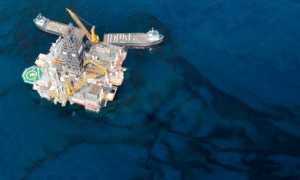http://www.sfgate.com/cgi-bin/article.cgi?f=/g/a/2010/05/30/bloomberg1376-L3AKFD0UQVI9-1.DTL
May 31 (Bloomberg) — BP Plc said in permit applications for drilling in the Gulf of Mexico that it was prepared to handle an oil spill more than ten times larger than the one now spewing crude into the waters off the southern United States.
“Proper execution of the procedures detailed in this manual will help to limit environmental and ecological damage to sensitive areas as well as minimizing loss or damage to BP facilities in the event of a petroleum release,” the company said in its oil-spill response plan, filed with the U.S. Minerals Management Service in 2008.
The company listed as its worst-case scenario a blowout in an exploratory well 57 miles west of the disaster, in a valley on the seafloor known as Mississippi Canyon. It’s about 33 miles off the coast of Louisiana. Such a blowout could have spewed 250,000 barrels a day, according to the 582-page plan.
The representations show that BP overestimated its ability to control an oil spill in waters where it’s the biggest player in a Gulf energy extraction industry worth $52 billion a year, said Bob Deans, a spokesman with the Natural Resources Defense Council in Washington.
“BP has obviously overpromised and underdelivered,” Deans said. “They told us they had a plan that could deal with the consequences of a worst-case scenario. They don’t.”
The plan was posted on the Minerals Management Service website and was incorporated by reference into BP’s application with the agency for a permit to drill the Macondo well. The company said in that application that a worst-case blowout from that well could spew at most 162,000 barrels a day.
BP’s ‘Plan in Place’
On April 20, a blowout there caused the drilling rig, Deepwater Horizon, to explode and then sink, leaving an open wellhead spewing as much as 19,000 barrels of oil a day into the Gulf waters. The company has failed so far to stop the gusher.
“Clearly we do have an oil-spill response plan in place, it was an integral part of our permitting with the MMS and it was specifically agreed with and approved by the MMS,” BP spokesman David Nicholas said in an e-mailed statement. “It sets out the actions, considerations, plans and steps that will be used in the case of an oil spill, and it is this plan that has been in action in response.”
Every well that a company drills has to be covered by a response plan that includes a worst-case scenario, said Kendra Barkoff, a spokeswoman with the Minerals Management Service.
‘Fundamental Questions’
“The BP Deepwater Horizon oil spill, however, raises several fundamental questions about safety and about industry’s ability to respond to spills,” she said in an e-mailed statement. ” We have launched a full investigation of the oil spill and are in the process of implementing new safety requirements to ensure this doesn’t happen again.”
BP fell 26 pence to 494.8 pence in London trading this morning and has lost 29 percent of its market value since the blast.
BP’s plan says it has contracts with the Marine Spill Response Corp. of Herndon, Virginia, and the National Response Corp. of Great River, New York, to contain and clean up any spills through the use of dispersant chemicals sprayed from airplanes and skimming vessels that would suck up oil-filled water.
The company would also use containment booms to control the spread of oil in the Gulf and work with local environmental groups to clean affected wildlife, according to the plan.
Documents Sought
The House Energy and Commerce Committee, investigating the Gulf of Mexico oil spill, is seeking documents from the clean-up consultants. Chairman Henry Waxman, a California Democrat, and oversight subcommittee Chairman Bart Stupak, a Michigan Democrat, sent letters on May 28 to National Response, a unit of Seacor Holdings Inc., Marine Spill Response, and O’Brien’s Response Management Inc. of Spring, Texas.
Waxman’s committee has reviewed 105,000 documents provided by companies connected with the rig.
BP’s plan says that those companies have enough oil- skimming vessels to remove about 492,000 barrels of oil a day from the water. The companies have the capacity to store 299,000 barrels a day, according to the plan.
BP spokesman John Curry said yesterday that so far, the company, through its contractors, has deployed 91 skimming vessels that have picked up a total of 312,952 barrels of oily water mixture from the spill that has gushed for almost six weeks. “That’s not all oil, it’s oily water,” he said.
A Prolonged Spill
He said the company had spread more than 3 million feet of containment boom, a floating plastic barrier designed to contain the spread of oil and direct it to skimming vessels. The boom was enough to cover about 350 miles of coastline, he said.
BP’s plan foresaw the possibility of a prolonged spill.
“If the spill went unabated, shoreline impact would depend upon existing environmental conditions,” according to the plan.
The chance of oil reaching the shoreline within 30 days was estimated at 3 percent or less for most coastal areas, except Louisiana’s Plaquemines Parish, which the company said had a 21 percent chance of seeing oil onshore within 30 days.
Louisiana Governor Bobby Jindal said on May 19 that oil was washing ashore in the Plaquemines wetlands.
BP said yesterday that a plan to stop the leak through a strategy of pumping in heavy mud and debris, known as “top kill,” failed. The company now plans to place a cap over the well.
The spill has cost BP a total of $760 million, or about $22 million a day, the company said May 24. BP’s average daily profit last year was $45 million a day, according to data compiled by Bloomberg.
–With assistance from Joe Carroll in Chicago and Lorraine Woellert in Washington. Editors: Jeffrey Taylor, Larry Liebert
Special thanks to Richard Charter
